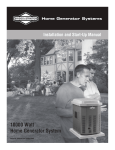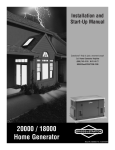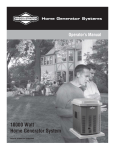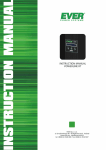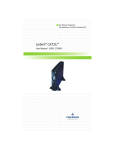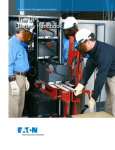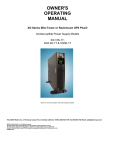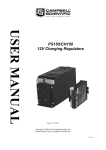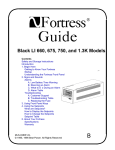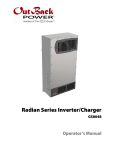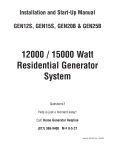Download Briggs & Stratton 10000 Watt Home Generator System Operator`s manual
Transcript
Home Generator Systems Installation and Start-Up Manual 10000 Watt Home Generator System Manual No. 205750GS Rev. B (05/29/2008) Thank you for purchasing this quality-built Briggs & Stratton home generator. We’re pleased that you’ve placed your confidence in the Briggs & Stratton brand. When operated and maintained according to the instructions in the operator’s manual, your Briggs & Stratton home generator will provide many years of dependable service. This manual contains safety information to make you aware of the hazards and risks associated with home generator systems and how to avoid them. This home generator system is designed and intended only for use as an optional home standby system that provides an alternate source of electric power and to serve loads such as heating, refrigeration systems, and communication systems that, when stopped during any power outage, could cause discomfort or inconvenience. This product is not intended for any other purpose and does not qualify for emergency standby as defined by NFPA 70 (NEC). This home generator requires professional installation before use. This installation manual provides full information. Follow the instructions completely. Save these instructions for future reference. Where to Find Us You never have to look far to find Briggs & Stratton support and service for your generator. Consult your Yellow Pages. There are thousands of Briggs & Stratton authorized service dealers worldwide who provide quality service. You can also contact Briggs & Stratton Customer Service by phone at (800) 743-4115, or use the Service Center Locator at BRIGGSandSTRATTON.COM, which provides a list of Briggs & Stratton Authorized Dealers. Date of Purchase Generator Model Number Model Revision Serial Number Engine Model Number Briggs & Stratton Power Products Group, LLC 900 North Parkway Jefferson, WI 53549 Copyright © 2008 Briggs & Stratton Power Products Group, LLC. All rights reserved. No part of this material may be reproduced or transmitted in any form by any means without the express written permission of Briggs & Stratton Power Products Group, LLC. Table of Contents Important Safety Instructions. . . . . . . . . . . . . . . . . . . . . . . . 4 Hazard Symbols and Meanings . . . . . . . . . . . . . . . . . . . . . . . . . . . . . . . . . . 4 Installation . . . . . . . . . . . . . . . . . . . . . . . . . . . . . . . . . . . . 7 Equipment Description. . . . . . . . . . . . . . . . . . . . . . . . . . . . . . . . . . . . . . . . . 7 Customer Responsibilities . . . . . . . . . . . . . . . . . . . . . . . . . . . . . . . . . . . . . . 7 Installer Responsibilities . . . . . . . . . . . . . . . . . . . . . . . . . . . . . . . . . . . . . . . 7 Unpacking Precautions . . . . . . . . . . . . . . . . . . . . . . . . . . . . . . . . . . . . . . . . 7 Delivery Inspection. . . . . . . . . . . . . . . . . . . . . . . . . . . . . . . . . . . . . . . . . . . . 7 Shipment Contents. . . . . . . . . . . . . . . . . . . . . . . . . . . . . . . . . . . . . . . . . . . . 7 Home Generator Location . . . . . . . . . . . . . . . . . . . . . . . . . . . . . . . . . . . . . . 8 Fuel and Electrical Inlet Locations . . . . . . . . . . . . . . . . . . . . . . . . . . . . . . . . 9 Lifting the Generator . . . . . . . . . . . . . . . . . . . . . . . . . . . . . . . . . . . . . . . . . . 9 Access Covers . . . . . . . . . . . . . . . . . . . . . . . . . . . . . . . . . . . . . . . . . . . . . . . 9 The Gaseous Fuel System . . . . . . . . . . . . . . . . . . . . . . . . . . . . . . . . . . . . . . 9 Fuel Consumption . . . . . . . . . . . . . . . . . . . . . . . . . . . . . . . . . . . . . . . . . . . 11 System Connectors . . . . . . . . . . . . . . . . . . . . . . . . . . . . . . . . . . . . . . . . . . 12 Generator AC Connection System . . . . . . . . . . . . . . . . . . . . . . . . . . . . . . . 13 Grounding the Generator . . . . . . . . . . . . . . . . . . . . . . . . . . . . . . . . . . . . . . 13 Utility Circuit Connection . . . . . . . . . . . . . . . . . . . . . . . . . . . . . . . . . . . . . . 13 Fault Detection System . . . . . . . . . . . . . . . . . . . . . . . . . . . . . . . . . . . . . . . 13 System Control Panel. . . . . . . . . . . . . . . . . . . . . . . . . . . . . . . . . . . . . . . . . 13 Final Installation Considerations . . . . . . . . . . . . . . . . . . . . . . . . . . . . . . . . 14 Fuel Supply System . . . . . . . . . . . . . . . . . . . . . . . . . . . . . . . . . . . . . . . . . . 14 Fuel System Selection . . . . . . . . . . . . . . . . . . . . . . . . . . . . . . . . . . . . . . . . 14 Initial Start-up (No Load) . . . . . . . . . . . . . . . . . . . . . . . . . . . . . . . . . . . . . . 14 Engine Adjustment . . . . . . . . . . . . . . . . . . . . . . . . . . . . . . . . . . . . . . . . . . . 15 Controls . . . . . . . . . . . . . . . . . . . . . . . . . . . . . . . . . . . . . 15 Operation . . . . . . . . . . . . . . . . . . . . . . . . . . . . . . . . . . . . 16 Automatic Operation Sequence . . . . . . . . . . . . . . . . . . . . . . . . . . . . . . . . . 16 Setting Exercise Timer . . . . . . . . . . . . . . . . . . . . . . . . . . . . . . . . . . . . . . . . 16 Installation Inspection . . . . . . . . . . . . . . . . . . . . . . . . . . . . . . . . . . . . . . . . 16 Vérification installation. . . . . . . . . . . . . . . . . . . . . . . . . . . . . . . . . . . . . . . . 18 3 Save These Instructions Important Safety Instructions The safety alert symbol ( ) is used with a signal word (DANGER, CAUTION, WARNING), a pictorial and/or a safety message to alert you to hazards. DANGER indicates a hazard which, if not avoided, will result in death or serious injury. WARNING indicates a hazard which, if not avoided, could result in death or serious injury. CAUTION indicates a hazard which, if not avoided, might result in minor or moderate injury. NOTICE indicates a situation that could result in equipment damage. Follow safety messages to avoid or reduce the risk of injury or death. This manual contains installation, startup and adjustment instructions for a home generator that supplies 120/240 Volt, single phase, 60Hz devices. The home generator may be operated on LP vapor or natural gas fuel. A separate operator’s manual contains operating and maintenance instructions for this model. Every effort has been made to ensure that the information in this manual is both accurate and current. However, the manufacturer reserves the right to change, alter or otherwise improve the system at any time without prior notice. Hazard Symbols and Meanings Explosion Toxic Fumes Rotating Parts Storage batteries give off explosive hydrogen gas during recharging. Slightest spark will ignite hydrogen and cause explosion. Battery electrolyte fluid contains acid and is extremely caustic. Contact with battery contents will cause severe chemical burns. A battery presents a risk of electrical shock and high short circuit current. • DO NOT dispose of battery in a fire. • DO NOT allow any open flame, spark, heat, or lit cigarette during and for several minutes after charging a battery. • DO NOT open or mutilate the battery. • Wear protective goggles, rubber apron, and rubber gloves. • Remove watches, rings, or other metal objects. • Use tools with insulated handles. WARNING Electrical Shock Fire WARNING Hot Surface Running engine gives off carbon monoxide, an odorless, colorless, poison gas. Breathing carbon monoxide can cause headache, fatigue, dizziness, vomiting, confusion, seizures, nausea, fainting or death. • Operate generator ONLY outdoors. • Install a battery operated carbon monoxide alarm near the bedrooms. • Keep exhaust gas from entering a confined area through windows, doors, ventilation intakes, or other openings. WARNING Auto Start Explosive Pressure Lift Hazard Chemical Burn Read Manual The engine exhaust from this product contains chemicals known to the State of California to cause cancer, birth defects, or other reproductive harm. WARNING Certain components in this product and related accessories contain chemicals known to the State of California to cause cancer, birth defects, or other reproductive harm. Wash hands after handling. 4 BRIGGSandSTRATTON.COM WARNING Generator produces hazardous voltage. Failure to properly ground generator can result in electrocution. Failure to isolate generator from power utility can result in death or injury to electric utility workers due to backfeed of electrical energy. • When using generator for backup power, notify utility company. • DO NOT touch bare wires or receptacles. • DO NOT use generator with electrical cords which are worn, frayed, bare or otherwise damaged. • DO NOT handle generator or electrical cords while standing in water, while barefoot, or while hands or feet are wet. • If you must work around a unit while it is operating, stand on an insulated dry surface to reduce shock hazard. • DO NOT allow unqualified persons or children to operate or service generator. • In case of an accident caused by electrical shock, immediately shut down the source of electrical power and contact the local authorities. Avoid direct contact with the victim. • Despite the safe design of the home generator, operating this equipment imprudently, neglecting its maintenance or being careless can cause possible injury or death. • Remain alert at all times while working on this equipment. Never work on the equipment when you are physically or mentally fatigued. • Before performing any maintenance on the generator, disconnect the battery cable indicated by a NEGATIVE, NEG or (-) first. When finished, reconnect that cable last. • After your home generator is installed, the generator may crank and start without warning any time there is a power failure. To prevent possible injury, always set the generator’s system switch to OFF, remove the service disconnect from the disconnect box AND remove the 15 Amp fuse BEFORE working on the equipment. WARNING Propane and Natural Gas are extremely flammable and explosive. Fire or explosion can cause severe burns or death. • Install the fuel supply system according to applicable fuel-gas codes. • Before placing the home generator into service, the fuel system lines must be properly purged and leak tested. • After the generator is installed, you should inspect the fuel system periodically. • NO leakage is permitted. • DO NOT operate engine if smell of fuel is present or other explosive conditions exist. • DO NOT smoke around the generator. Wipe up any oil spills immediately. Ensure that no combustible materials are left in the generator compartment. Keep the area near the generator clean and free of debris. WARNING Hazardous Voltage Contact with power lines can cause electric shock or burn. Lifting Hazard / Heavy Object Can cause muscle strain or back injury. • If lifting or hoisting equipment is used, DO NOT contact any power lines. • DO NOT lift or move generator without assistance. • DO NOT lift unit by roof as damage to generator will occur. 5 WARNING Contact with muffler area can result in serious burns. Exhaust heat/gases can ignite combustibles or structures causing a fire. • DO NOT touch hot parts and AVOID hot exhaust gases. • Allow equipment to cool before touching. • DO NOT install the generator closer than 5 feet (1.5m) from any combustibles or structures with combustible walls having a fire resistance rating of less than 1 hour. • Keep at least minimum distances shown in General Location Guidelines to insure for proper generator cooling and maintenance clearances. • Code of Federal Regulation (CFR) Title 36 Parks, Forests, and Public Property require equipment powered by an internal combustion engine to have a spark arrester, maintained in effective working order, complying to USDA Forest service standard 5100-1C or later revision. In the State of California a spark arrester is required under section 4442 of the California Public resources code. Other states may have similar laws. WARNING Starter and other rotating parts can entangle hands, hair, clothing, or accessories. • NEVER operate generator without protective housing or covers. • DO NOT wear loose clothing, jewelry or anything that may be caught in the starter or other rotating parts. • Tie up long hair and remove jewelry. CAUTION Installing the 15A fuse could cause the engine to start. • Observe that the 15 Amp fuse has been removed from the control panel for shipping. • DO NOT install this fuse until all plumbing and wiring has been completed and inspected. 6 CAUTION Excessively high operating speeds increase risk of injury and damage to generator. Excessively low speeds impose a heavy load. • DO NOT tamper with governed speed. Generator supplies correct rated frequency and voltage when running at governed speed. • DO NOT modify generator in any way. NOTICE Exceeding generators wattage/amperage capacity can damage generator and/or electrical devices connected to it. • See Essential Circuits in Operator’s manual. • Start generator and let engine stabilize before connecting electrical loads. NOTICE Improper treatment of generator can damage it and shorten its life. • Use generator only for intended uses. • If you have questions about intended use, ask dealer or contact Briggs and Stratton. • Operate generator only on level surfaces. • Adequate, unobstructed flow of cooling and ventilating air is critical to correct generator operation. • The Oil Fill, Oil Drain and the Control Panel doors must be installed whenever the unit is running. • DO NOT expose generator to excessive moisture, dust, dirt, or corrosive vapors. • Despite the safe design of the home generator, operating this equipment imprudently, neglecting its maintenance or being careless can cause possible injury or death. • Remain alert at all times while working on this equipment. NEVER work on the equipment when you are physically or mentally fatigued. • DO NOT start engine with air cleaner or air cleaner cover removed. • DO NOT insert any objects through cooling slots. • DO NOT use the generator or any of its parts as a step. Stepping on the unit can cause stress and break parts. This may result in dangerous operating conditions from leaking exhaust gases, fuel leakage, oil leakage, etc. • If connected devices overheat, turn them off and disconnect them from generator. • Shut off generator if: -electrical output is lost; -equipment sparks, smokes, or emits flames; -unit vibrates excessively. BRIGGSandSTRATTON.COM Installation CAUTION Equipment Description This product is intended for use as an optional home generator system which provides an alternate source of electric power and to serve loads such as heating, refrigeration systems, and communication systems that, when stopped during any power outage, could cause discomfort or inconvenience. This product does not qualify for emergency standby as defined by NFPA 70 (NEC). Customer Responsibilities • Read and follow the instructions given in the Operator’s Manual, especially the section regarding selecting essential circuits. • Follow a regular schedule in maintaining, caring for and using your home generator, as specified in the Operator’s Manual. Installer Responsibilities • Read and observe the safety rules. • Install only an UL approved transfer switches that is compatible with the home generator. • Read and follow the instructions given in this Installation and Start-up Manual. IMPORTANT: If operating the generator below 40°F, it is recommended that a battery and oil warmer be installed. If operating the generator below 32°F, a battery and oil warmer must be installed. Both items are available at your local servicing dealer. Unpacking Precautions The unit is shipped bolted to its mounting pad, ready for installation. Avoid damage from dropping, bumping, collision, etc. Store and unpack carton with the proper side up, as noted on the shipping carton. Installing the 15A fuse could cause the engine to start. • Observe that the 15 Amp fuse has been removed from the control panel for shipping. • DO NOT install this fuse until all plumbing and wiring has been completed and inspected. Delivery Inspection After removing the carton, carefully inspect the home generator for any damage that may have occurred during shipment. IMPORTANT: If loss or damage is noted at time of delivery, have the person(s) making delivery note all damage on the freight bill and affix his signature under the consignor’s memo of loss or damage. If loss or damage is noted after delivery, separate the damaged materials and contact the carrier for claim procedures. Missing or damaged parts are not warranted. Shipment Contents The home generator is supplied with: • Home generator • Pre-attached mounting pad • One flexible hook-up pipe (meets UL 569 and CSA 8.3) • This installation and start-up manual • Operator’s manual • Installation checklist • Oil drain tray • Touch up paint • One spare 15A fuse • Roof hardware bag • 2 Pole connector - 240V from house • 10 Pole connector - Sensing and control wires • Remote LED indicator kit (red LED/plate/screws) Required Items Supplied by Installer • Battery 7 Home Generator Location Before installing generator, consult with homeowner and convey the following guidelines which may affect the desired location. WARNING Exhaust heat / gasses can ignite combustibles or structures causing a fire. • DO NOT install the generator closer than 5 feet (1.5m) from any combustibles or structures with combustible walls having a fire resistance rating of less than 1 hour. • Keep at least minimum distances shown in General Location Guidelines to insure for proper generator cooling and maintenance clearances. Generator Location Install generator outdoors in an area which will not accumulate deadly exhaust gas. DO NOT install generator where exhaust gas could accumulate and enter inside or be drawn into a potentially occupied building. Ensure exhaust gas is kept away from any windows, doors, ventilation intakes or other openings that can allow exhaust gas to collect in a confined area. Prevailing winds and air currents should be taken into consideration when positioning generator. • Install the generator as close as possible to the Transfer Switch and fuel supply to reduce the length of wiring, conduit, and piping. IMPORTANT: Laws or local codes may regulate the distance to the fuel supply. The Minimum (MIN) clearances from aerial view of generator (B) to combustible (D), and non-combustible (A) materials is shown below. • These distances are provided to give generator location guidance relative ONLY to combustibles, generator cooling, and maintenance. • The minimum distances in the figure are as shown. All four sides of the generator cannot be enclosed or restricted, even if the minimum distances are maintained. DO NOT connect (A) and/or (D) to (E) • A roof cannot be used. • Exhaust (C) must not be allowed to accumulate. 5’ (1.5m) 3’ (1m) WARNING 3’ (1m) Running engine gives off carbon monoxide, an odorless, colorless, poison gas. Breathing carbon monoxide can cause headache, fatigue, dizziness, vomiting, confusion, seizures, nausea, fainting, or death. • Operate generator ONLY outdoors. • Install a battery operated carbon monoxide alarm near the bedrooms. • Keep exhaust gas from entering a confined area through windows, doors, ventilation intakes, or other openings. B 5’ (1.5m) D 5’ (1.5m) A C 5’ (1.5m) General Location Guidelines • Install the unit outdoors ONLY. • Place the unit in a prepared location that is flat and has provisions for water drainage. • Install the unit in a location where sump pump discharge, rain gutter down spouts, roof run-off, landscape irrigation, or water sprinklers will not flood the unit or spray the enclosure and enter any air inlet our outlet openings. • Install the unit where the location of any services such as phone, electrical, fuel, air conditioning, irrigation, including covered, concealed and underground services will not be affected or obstructed. • Install the unit where air inlet and outlet openings will not become obstructed by leaves, grass, snow, etc. If prevailing winds will cause blowing or drifting, you may need to construct a windbreak to protect the unit. 8 E E A Non-Combustible material with Fire Resistant Rating of 1 hour or greater B Home Generator System C Engine Exhaust D Combustible Material or Structure with a Fire Resistance Rating of less than 1 hour. E Any structure or material. DO NOT connect (A) and/or (D) to (E). BRIGGSandSTRATTON.COM The home generator is shipped already attached to its mounting pad. Unless mandated by local code, a concrete slab is not required. If mandated by local code, construct a concrete slab at least 3 inches thick and 6 inches longer and wider than the unit. Attach unit to slab with 1/4” diameter (minimum) masonry anchor bolts long enough to retain the unit. Fuel and Electrical Inlet Locations The fuel inlet connector (A) and electrical inlet (B) is shown below. B 4.5” A Access Covers The home generator is equipped with an enclosure that has a removable roof and an access cover for the control panel. To Remove Roof: Remove the four screws and lift off. To Remove Access Cover: 1. Remove roof as described above. 2. Remove screw at top of access cover. 3. Pull access cover outward (away) from unit while pulling cover upward and out of base. Cover will come free. To Install Access Cover and Roof: 1. Guide bottom of access cover into base. 2. Push access cover until it is flush with sides. 3. Replace cover screw. 4. Replace roof and screws. The Gaseous Fuel System 13.5” WARNING Propane and Natural Gas are extremely flammable and explosive. Fire or explosion can cause severe burns or death. Lifting the Generator The generator weighs more than 430 pounds. Proper tools, equipment and qualified personnel should be used in all phases of handling and moving the generator. WARNING Hazardous Voltage Contact with power lines can cause electric shock or burn. Lifting Hazard / Heavy Object Can cause muscle strain or back injury. • If lifting or hoisting equipment is used, DO NOT contact any power lines. • DO NOT lift or move generator without assistance. • DO NOT lift unit by roof as damage to generator will occur. Lifting pockets are provided at each corner between the base of the generator and its mounting pad. Retouch any chipped paint with supplied touch-up paint. • LP gas is heavier than air and will settle in low areas. • Natural gas is lighter than air and will collect in high areas. • The slightest spark can ignite these fuels and cause an explosion. • DO NOT light a cigarette or smoke. The information provided below is to assist gaseous fuel system technicians in planning installations. In no way should this information be interpreted to conflict with applicable fuel gas codes. Consult with your local fuel supplier or Fire Marshall if questions or problems arise. TO THE INSTALLER: Consult with the home generator owner(s) and convey any technical considerations that might affect their installation plans before applying these general guidelines. The following general rules apply to gaseous fuel system piping: • The piping should be of a material that conforms to federal and local codes, rigidly mounted and protected against vibration. • Piping should be protected from physical damage where it passes through flower beds, shrub beds, and other cultivated areas where damage could occur. 9 • Install the flexible, gaseous hose (supplied) between the home generator Fuel Inlet port and rigid piping to prevent thermal expansion or contraction from causing excessive stress on the piping material. NOTE: Where local conditions include earthquake, tornado, unstable ground, or flood hazards, special consideration shall be given to increase strength and flexibility of piping supports and connections. CAUTION The supplied flexible gaseous pipe is not to be installed underground or in contact with the ground. • The entire flexible gaseous pipe must be visible for periodic inspection and must not be concealed within, contact, or run through any wall, floor, or partition. • Piping must be of the correct size to maintain the required supply pressures and volume flow under varying generator load conditions with all gas appliances connected to the fuel system turned on and operating. • Use an approved pipe sealant or joint compound on all threaded fittings to reduce the possibility of leakage. • Installed piping must be properly purged and leak tested, in accordance with applicable codes and standards. The Home Generator has been factory set to run on natural gas. If you need to change from natural gas to LP gas, the unit will need to be reconfigured, as described in Fuel System Selection. It is recommended that the fuel connection incorporate the following components: • A manual fuel shut-off valve located in the interior of the building. • A manual fuel shut-off valve located outside the building, just before the generator unit. • Where the formation of hydrates or ice is known to occur, piping should be protected against freezing. The termination of hard piping should include a sediment trap where condensate is not likely to freeze. • A manometer port should be provided. The manometer port permits temporary installation of a manometer to ensure that the engine receives the correct fuel pressure to operate efficiently throughout its operating range. WARNING Propane and Natural Gas are extremely flammable and explosive. Fire or explosion can cause severe burns or death. • Before placing the home generator into service, the fuel system lines must be properly purged and leak tested. • NO leakage is permitted. Consider the following factors when planning to install the fuel supply system: The home generator engine is fitted with a fuel mixer system that meets the specifications of the California Air Resources Board for “tamper-proof” fuel systems. • A minimum of one accessible, approved manual shutoff valve shall be installed in the fuel supply line within 6 ft (1.8 m) of the home generator. A union or flanged connection shall be provided downstream from this valve to permit removal of controls. • Natural gas fuel supply pressure at the generator’s fuel inlet port should be between 5 to 7 inches of water (in. W.C.) at full load. • LP gas fuel supply pressure should be 11 to 14 inches of water (in. W.C.) at full load with all gas appliances turned on and operating. 10 NOTE: A digital manometer, P/N 19495, is available at your local Briggs & Stratton service center. When the initial test runs are completed, the manometer is removed and the port is plugged. A typical final fuel connection assembly is shown here, where (A) is the fuel supply and (B) goes to the home generator. A B BRIGGSandSTRATTON.COM Fuel Consumption Estimated fuel supply requirements at half and full load for natural gas and LP vapor fuels are shown below. Natural Gas LP Vapor 1/2 Load Full Load 1/2 Load Full Load 84 C 162 C 35 C 65 C 84,000 B 162,000 B 86,375 B 163,625 B C = Cubic feet per hour B = BTU’s per hour Fuel Pipe Sizing The tables below provide the maximum capacity of pipe in cubic feet of gas per hour for gas pressures of 0.5 psi or less and a pressure drop of 0.3 in. water column. Specific gravity of gas is shown. Listed values compensate for a nominal amount of restriction from bends, fittings, etc. If an unusual number of fittings, bends, or other restrictions are used, please refer to federal and local codes. Physical Properties LP Vapor Natural Gas Normal Atmospheric State Gas Gas Boiling Point (in °F): Initial End -44 -44 -259 -259 Heating Value: BTU per gallon (Net LHV*) BTU per gallon (gross**) Cubic feet (gas) 83,340 91,547 2,500 63,310 Density*** 36.39 57.75 Weight† 4.24 2.65 Octane Number: Research Motor 110+ 97 110+ 1,000 * ** LHV (Low Heat Value) is the more realistic rating. Gross heat value does not consider heat lost in the form of water during combustion. *** Density is given in “Cubic Feet of Gas per Gallon of Liquid”. † Weight is given in “Pounds per Gallon of Liquid”. NPT 10ft 15ft 20ft 30ft 40ft 50ft 60ft 70ft 80ft 90ft 100ft 3/4” 346 293 240 192 163 145 132 120 113 106 99 1” 653 549 446 360 307 274 250 230 211 197 187 Natural Gas Pipe Size - Gas Flow chart, in cubic feet per hour, specific gravity=0.65 NPT 10ft 15ft 20ft 30ft 40ft 50ft 60ft 70ft 80ft 90ft 100ft 3/4” 277 192 158 126 107 95 87 79 74 69 65 1” 428 360 293 236 202 180 164 151 139 129 123 Liquid Propane (LP) Gas Pipe Size - Gas Flow chart, in cubic feet per hour, specific gravity=1.50 Required Propane Tank Size The required size of the propane tank at various temperatures when kept at least half full is shown below in the chart. Given the gas withdrawal rate and the lowest average winter temperature, an installer can specify the required LP storage tank size. Withdrawal Rate 32° F 20° F 10° F 0° F -10° F -30° F -40° F 50 CFH 115 115 115 250 250 400 600 100 CFH 250 250 250 400 500 1000 1500 150 CFH 300 400 500 500 1000 1500 2500 200 CFH 400 500 750 1000 1200 2000 2500 300 CFH 750 1000 1500 2000 2500 4000 5000 11 System Connectors Except for the power output and grounding connectors, all signal wire connections are made to removable two- or ten-pin connector plugs. Compare this illustration with your generator to familiarize yourself with the location of these important connections: A B C D E F G A - 2 Pole Connector Plug B - 240 Volt Utility — Use to hook up the 240V utility leads from the transfer switch to the generator. C - +12 Volt DC, .5 Amp Output — Internal power supply. D - Remote LED Output — Use this to hook up the remote LED supplied with the generator. The remote LED will turn on and off in a series of blinks if certain faults are detected in the generator. 12 E - Transfer Switch Communication — Use TxRx and TxRx GND to transfer switch to monitor transfer switch functions. F - Fault Contacts — Use NO, COM and NC to hook up a siren, light, optional GenAlert, etc. to alert you in case of a fault. Contacts reverse state (NO goes to NC and vice versa) upon a fault condition. G - 10 Pole Connector Plug BRIGGSandSTRATTON.COM Generator AC Connection System System Control Panel A single-phase, three-wire AC connection system is used in the home generator. The stator assembly consists of a pair of stationary windings with two leads brought out of each winding. The junction of leads 22 and 33 forms the neutral lead. Keep field wiring to a minimum. A complete schematic and wiring diagram can be found in the separate operator’s manual. NOTE: Neutral is not bonded to ground at generator. The home generator control panel, located inside the generator housing, is shown below. Grounding the Generator Ground the home generator per applicable codes, standards, and regulations. The generator GND lug is located in the control panel box. Utility Circuit Connection “240V Utility” leads must be routed in conduit. The “240V Utility” leads deliver power to the generator’s circuit board, optional battery warmer and optional oil warmer. This power also charges the battery. When power on these leads is lost, the generator will start. Using provided 2 pole connector plug and installer-supplied minimum 300V, 14 AWG copper wire, connect each control circuit terminal in the generator to the two-amp fuse terminals in the automatic transfer switch. Fault Detection System The generator may have to run for long periods of time with no operator present. For that reason, the system is equipped with sensors that automatically shut down the generator in the event of potentially damaging conditions, such as low oil pressure, high oil temperature, over speed, and other conditions. Refer to Fault Detection System in the Operator’s Manual for more detailed information. The owner will use the remote LED indicator to observe the status of the home generator system. Consult with the owner for a convenient location. To install the remote LED indicator: 1. Push the LED through the mounting plate from the front until it snaps in place. IMPORTANT: The LED is polarity sensitive. 2. Using provided 10 pole connector and installer-supplied minimum 18AWG wire, connect the remote LED to the generator control board +LED and GND connection. Use wire nuts to attach wire to LED leads. 3. Attach mounting plate to installer-supplied electrical box. NOTE: Locate the electrical box in an area visible by the home owner such as near a garage door opener or security control panel. A B C F E D Brief descriptions of the controls used during installation are: A - System Switch — Switches modes to OFF and AUTO. B - Manual Over-Ride Switch — Turns generator ON or OFF. C - Digital Display — Displays running time and fault codes. D - Set Exercise Switch — Used to set the exercise cycle. E - 15 Amp Fuse — Protects the DC control circuits. F - Circuit Breaker — Must be ON to supply power to the transfer switch. More information may be found in Controls in the Operator’s Manual. System Switch This two-position switch is the most important control on the home generator and is used as follows: • “AUTO” position is the normal operating position. If a utility power outage is sensed, the system will start the generator. When utility power is restored, lets the engine stabilize internal temperatures, shuts off the generator, and waits for the next utility power outage. • “OFF” position turns off running generator, prevents unit from starting and resets any detected faults. 15 Amp Fuse Protects the home generator DC control circuits. If the fuse has ‘blown’ (melted open) or was removed, the engine cannot crank or start. Replace the fuse using only an identical ATO 15A fuse. One spare fuse is supplied with the unit. If fuse was blown or removed, you will need to reset the excercise timer (see Setting Excercise Timer). 13 Final Installation Considerations Engine Oil NOTICE Any attempt to crank or start the engine before it has been properly serviced with the recommended oil will result in equipment failure. • Refer to Maintenance and engine manual for oil fill information. • Damage to equipment resulting from failure to follow this instruction will void engine and generator warranty. This engine is shipped from the factory pre-run and filled with synthetic oil (API SJ/CF 5W-30W). This allows for system operation in the widest range of temperature and climate conditions. Before starting the engine, check oil level and ensure that engine is serviced as described in the engine operator’s manual. NOTE: The use of synthetic oil does not alter the required oil change intervals described in the engine operator’s manual. Battery The installer must supply and install a sealed, valveregulated, lead-acid rechargeable starting battery. The starting battery MUST conform to the specifications shown below in the chart. Fuel Supply System Ensure that all fuel pipe connections are tight, secure and without leaks. Ensure that all gas line shutoff valves are OPEN and that adequate fuel pressure is available whenever automatic operation is desired. Fuel System Selection The engine of your Home Generator System is factory calibrated to run on natural gas (NG). It may also be operated on liquefied petroleum (LP) vapor. There is no additional hardware/equipment required to switch between either fuel. However, LP fuel inlet pressure must be between 11 and 14 inches water column. To configure the fuel system for LP use: 1. Remove control panel and oil fill access covers. 2. Set generator’s system switch to OFF. 3. Remove 15 Amp fuse from control panel. 4. Connect the fuel select solenoid by joining the two-pin electrical connector (A). A Battery Specifications Volts 12 Volt DC Amps (MIN) 350 CCA (cold cranking amps) Type AGM Terminal Hardware M8 Dimensions (MAX): Width 5.325 inches (135mm) Length 7.875 inches (200mm) Height 6.875 inches (175mm) 5. Reinstall 15 Amp fuse in control panel. 6. Set generator’s system switch to AUTO. 7. Install control panel and oil fill access covers. The system is now ready to operate automatically using LP fuel. With a fixed main jet for LP gas, there is no need to perform any engine adjustments for LP operation. NOTE: DO NOT use a deep-cycle or automotive type battery. Install the battery as described in Servicing the Battery in the Maintenance section of the operator’s manual. Always make sure the negative cable is connected last. The battery may not be at full charge when installed. If battery voltage is below 12 Volts, charge the battery. See Battery in Maintenance of the operator’s manual for details. WARNING Battery posts, terminals and related accessories contain lead and lead compounds, chemicals known to the State of California to cause cancer and reproductive harm. Wash hands after handling. 14 BRIGGSandSTRATTON.COM Initial Start-up (No Load) Before operating the home generator or placing it into service, inspect the entire installation carefully. Then begin testing the system without any electrical loads connected, as follows: 1. Set generator’s main circuit breaker to its ON (closed) position. 2. Install 15 Amp fuse in control panel. 3. Set generator’s system switch to AUTO. 4. Push MANUAL OVER-RIDE button on control panel. NOTE: When the home generator is started for the very first time, it will require that air in the gaseous fuel lines be purged. This may take a few minutes. 5. DO NOT crank engine for more than 10 seconds, then pause for 10 seconds to reduce heat in the starter. 6. Repeat process until engine starts. 7. Listen for unusual noises, vibration or other indications of abnormal operation. Check for oil leaks while engine runs. 8. Let engine warm up for about five minutes to allow internal temperatures to stabilize. 9. Connect an accurate AC voltmeter and a frequency meter to check generator output at load side of circuit breaker. Voltage should be 239-262 Volts, frequency should be 62.0 - 62.5 Hz. NOTE: If either parameter is outside these ranges, perform the Engine Adjustments described below. 10. Check generator output between one of the generator connection lugs and the neutral lug, then between the other generator connection lug and the neutral lug. In both cases, voltage reading should be between 119-131 Volts. 11. Push and hold MANUAL OVER-RIDE button on control panel again until engine stops. IMPORTANT: DO NOT proceed until you are certain that generator AC voltage and frequency are correct and within the stated limits. To obtain the proper generator frequency, see Engine Adjustments. Engine Adjustment There are regional variances in the composition of natural gas. Each home generator unit leaves the factory set for NG operation. If the generator output voltage or frequency measured during Initial Start-Up (paragraph #9) is outside the listed ranges, the combustibility of the gas supplied at the installation site may be substantially different from the fuel used at the factory. To adjust the engine for this difference, proceed as follows. 1. Remove the oil drain and control panel access covers. 2. Connect an accurate frequency meter to the line side of the generator’s main circuit breaker. 3. Ensure that the 15 Amp fuse is installed. 4. Set the generator’s main circuit breaker ON. 5. Set the generator’s system switch to AUTO. 6. Push MANUAL OVER-RIDE button on control panel. When the engine starts, allow it to warm up for five minutes. 7. Normal no load frequency is 62.0 to 62.5 Hz. If adjustment is needed at no load, slowly rotate the governor adjustment nut (A) clockwise and/or counterclockwise until frequency is 62.0 to 62.5 Hz. A 8. Push and hold MANUAL OVER-RIDE button on control panel again until engine stops. 9. Turn the service disconnect to the transfer switch off. After a short time delay, the transfer switch will connect to the generator. 10. Load generator to full load. 11. Connect an accurate frequency meter to the load side of the generator’s main circuit breaker. Frequency should be above 57.0 Hz. 12. If frequency is below 57.0 Hz, slowly rotate the governor adjustment nut or screw clockwise and/or counterclockwise until frequency is above 57.0 Hz. 13. Turn the service disconnect to the transfer switch on. The transfer switch will connect to the utility after five minutes. 14. After the engine has stopped running, • If an adjustment was made in step 12, repeat steps 3 through 8. • If an adjustment was not made in step 12, proceed to step 15. IMPORTANT: If the no load frequency falls out of the no load parameter after full load adjustment is made, contact an authorized service center. 15. Install the oil drain and control panel access covers. 15 Controls See the Operator’s Manual for complete description of the home generator controls. Operation Automatic Operation Sequence The generator’s control panel houses a logic control circuit board. This control board constantly monitors utility power source voltage. Should that voltage drop below a preset level, control board action will signal the engine to crank and start. When utility source voltage is restored above a preset voltage level, the engine is signaled to shut down. The actual system operation is not adjustable and is sequenced by sensors and timers on the control board, as follows: Utility Voltage Dropout Sensor • This sensor monitors utility source voltage. • If utility source voltage drops below about 70 percent of the nominal supply voltage, the sensor energizes a 10 second timer. The timer is used to ‘sense’ brownouts. • Once the timer has expired, the engine will crank and start. Utility Voltage Pickup Sensor This sensor monitors utility power supply voltage. When that voltage is restored above 80 percent of the nominal source voltage, a time delay starts timing and the engine will go to engine cool-down. Engine Cool-down Timer • When the load is transferred back to the utility power source, the engine cool-down timer starts timing. • The timer will run for about one minute, then the generator will stop. • Minimum engine run time is 5 minutes. Setting Exercise Timer The home generator is equipped with an exercise timer that will start and exercise the system once every seven days. During this exercise period, the unit runs for approximately 20 minutes and then shuts down. Electrical load transfer DOES NOT occur during the exercise cycle (unless an utility power outage occurs). A button on the control panel is labeled “Set Exercise” (see System Control Panel). The specific day and the specific time of day this button is pressed is programmed into the control board memory. This date and time is then used to automatically initiate the system exercise cycle. The “SET EXERCISE” legend on the control panel will flash until the set exercise cycle is set. To perform the Set Exercise procedure: 1. Choose the day and time you want your home generator to exercise. 2. On that day and time, press and hold down the “Set Exercise” button for three seconds. NOTE: “SET EXERCISE” will flash until the button is pressed for three seconds, then “SET EXERCISE” will illuminate for 5 seconds, and finally turn off. 3. The unit will then start and run it’s 20 minute exercise cycle. For example, if you press the “Set Exercise” button on Sunday morning at 10:00 AM, the unit will run an immediate exercise cycle and then the following Sunday at 10:00 AM (+/- 1/2 hour). NOTE: “Set Exercise” will only work if the unit is in the Automatic mode and this exact procedure is followed. The exerciser will need to be re-set if the 15 Amp fuse is removed or changed, or if the 12 Volt DC battery is disconnected. If you want to change the day and time the unit exercises, simply perform the “Set Exercise” procedure at the exact weekday and time you want it to take place. Installation Inspection Complete the ”Installation Checklist” as you make the inspection. Ensure all items have been filled-in and all signatures have been obtained. Instruct the owner to mail the white copy to: Briggs & Stratton Power Products Warranty Registration P. O. Box 239 Jefferson, WI 53549-0239 More detailed Operating, Maintenance and Troubleshooting information is given in the Operator’s Manual. 16 BRIGGSandSTRATTON.COM
















